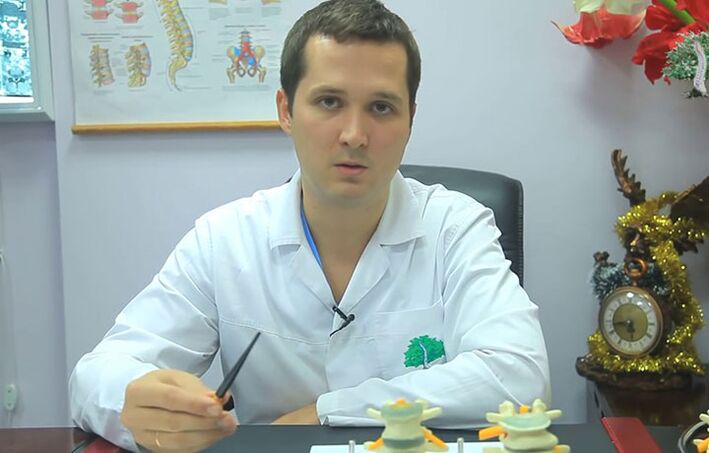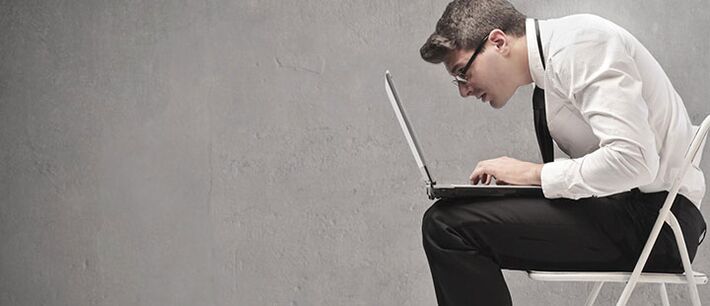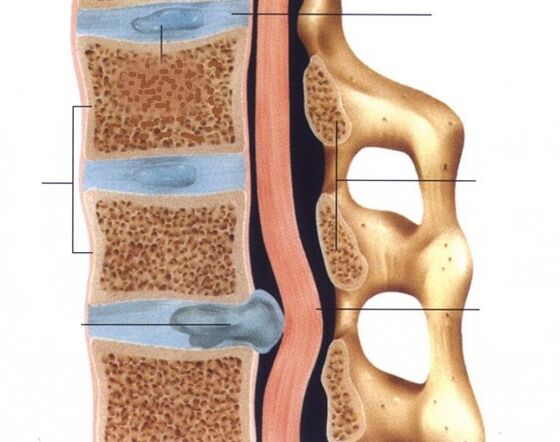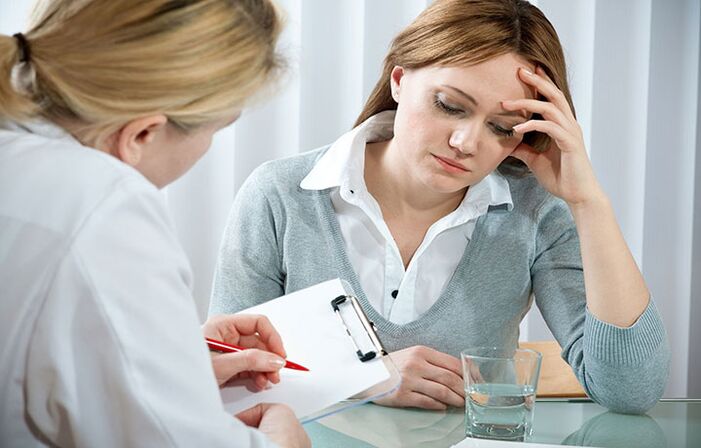Osteochondrosis is perhaps one of the main positions of the modern series of problems of the musculoskeletal system.A person of the 21st century is not able to fully normalize their physical activity, and it is the main reason for the violations of the activity of the functioning of their skeleton.
Pain in the legs, complaints of muscle fatigue, reduction in activity and a significant deterioration in quality of life - far from all drawbacks.On X -ray and MRI images, changes in the integrity of intervertebral discs are clearly perceptible.

How the spine suffers
The ridge assumes the maximum body weight pressure during movements.Inactive and excessive loads (for example, weight loss) are also harmful to the two most important substances in the spine - bone and cartilage.
Particular loads are forced to withstand the lower sections of the neck and the Lombo-Sacred spine.When the spine is overloaded, the load distribution is incomplete.Consequently, cervical osteochondrosis or osteochondrosis of the lumbar column can manifest itself.The simple and the treatment of the latter must be considered in more detail.
The lumbar vertebrae are large and wide, connected to each other less mobile than the vertebrae of the chest or the cervical region.The sacrum is formed by the vertebrae with flexible vertebrae, which are equipped with protection - intervertebral cartilaginous discs.They compensate for cerebral vascular accidents and stretch during the walking and displacement of important objects.
Destruction of the disc is the cause of pain
The wheels between the vertebrae have a structure resembling a very dense elastic jelly.It is a variety of cartilage.For proper functioning, it must be well supplied with liquids and nutrients.Any vascular change implies the drainage of the peripheral part of the disc - the fibrous ring, then its central region - the pulpoose nucleus.
If the fibrous ring breaks, a hernia forms in its place, which tightens the roots of the nerves extending from the vertebral segment, overlap the blood flow and normal innervation. Such anatomical signs of lumbar osteochondosis are not harmless, so it will not work to cure lumbar osteochondosis from a click of the fingers or simply drink a pill.
Such anatomical signs of lumbar osteochondosis are not harmless, so it will not work to cure lumbar osteochondosis from a click of the fingers or simply drink a pill.
Doctors are the alarm
Medical statistics say that around 80% of the capable coded population already knows in force what osteochondrosis of the lumbar column is.These patients are treated at home themselves.Less than half of them are decided to call on doctors.Meanwhile, the delay is not sure for health, as it is necessary to treat osteochondrosis in the lumbar region in the early stages, when its effect can still be offset.
Since damage mainly affects a fibrous disk substance (cartilage), the disease is sometimes called intervertebral osteochondosis.If osteochondrosis of the lombo-sacular column is capable of developing, the pathological changes soon in the cartilaginous tissue will be completed by the destruction of the bone segments of the spine.
The innervation of the lower parts of the body depends on the lumbar and sacred nerves, so that the signs of osteochondrosis in the lumbar column are mainly associated with pain.Even the strongest and most reliable vertebrae on the lower back can fail.And the pain will be felt in the legs and back.
In the same part of the skeleton, the largest nerve is placed - sciatica.Ishias are a nerve disease, inflammation of this nerve.The first cause of Ishias often becomes precisely osteochondrosis of the lower spine.
Recognition and diagnosis
The patient rarely goes to the doctor immediately, while the pain can still be endured - it is the mentality of a working citizen.Symptoms of lumbar osteochondrosis in women and men do not differ, except when the innervation is altered.In women - uterus and appendages, in men, there is sexual dysfunction.
The destruction of cartilage can only be located in the lumbar region or only in the sacrum.The main symptoms of osteochondrosis of the lumbar column and sacred osteochondosis (symptoms) can be distinguished by radicular symptoms: violation of the roots of the spinal brain nerve leads to the appearance of problems in the organs that this nervous path controls.
With osteochondrosis of the lumbar column, it is usual to consider lumbar syndrome: acute pain in the lower back, painful sensations on the back.The legs also hurt, there is a change of approach, skin sensitivity and numb muscle.
If the compression of the roots leads to inflammation, the swelling develops.In the context of poisoning, muscles, joints, ligaments begin to actually, with physical activity.Patients also complain about increased perspiration.
Osteochondrosis of the sacred spine is determined by the problems of the basin (for example, the altered functions of the muscles of the perineum, including the penis in men; the difficulties of defecation and urination are possible).
More often than not, the symptoms are mixed and we are talking about a more widespread lesion of the spine, which will be designated in the medical file as osteochondrosis of the lumbar column.The treatment is very individual, because the signs of osteochondrosis in the lombo-sacular spine are diversified in each therapeutic case.
When the blood vessels are compressed, the blood intake of the muscles is disturbed.Walking is accompanied by frequentness and frequent stops for relaxation.Thigh muscles, perineum, buttocks do not receive nutrition.This is described in medical practice as ischemic lumbar osteochondosis syndrome.

If neurological and ischemic signs, accompanied by pain too long affected, then the deformation of the skeleton begins from the constant forced pose and the spasm of the muscles.And not only the spine, but also the members.The mosque and familiar poses and the approach change.Osteochondrosis is not treated quickly and visiting a doctor is a compulsory measure to succeed in overcoming the disease.
Whether it is sacred or lumbar osteochondosis, symptoms must be assessed in a complete and professional manner, not to mention your own logic or opinion to embrace grandmothers.And treatment is preferable to trust professional specialists.
Medical diagnostic methods
Having suspected osteochondrosis of the lumbar region, whose symptoms are given in the previous paragraph, the patient can independently assume the diagnosis.But the professional diagnosis is not limited to only questions about well-being.The doctor carefully palpates the painful areas around the spine and discovers the location of the problem.During this part of the examination, the consequences of osteochondrosis are revealed: cyphosis (vertebral deformation), scoliosis (curvature of the spine), lordosis (change in the physiological turn of the spine), asymmetry of the members of the limbs (often muscle shots), tensions and disadvantages in the lower back (muscular muscles).
On the X -ray in two projections, the structure of each vertebra is determined and the deformations and the growth of the tissues are detected.CT (Tomodensitometry) gives more images with a lower radiation load.And MRI is expanding the doctor's capacities, especially when planning surgical interventions for the treatment of osteochondrosis.
The choice of method must be made by the doctor according to concomitant diseases, because each visual methods can be contraindicated in a single patient.
The danger of the disease
The spine exercises two important functions - maintain the body in a vertical position and manage the unconscious functions of the body and unconditional reflexes.It is not difficult to guess how dangerous violations can be.
Causes and prevention of spine diseases
Neglecting your health and the first signals on problems lead to a natural result - osteochondrosis in the lumbar region is developing, the causes of which are generally found in daily events and conditions:
- The fact of simplicity is already a risk factor for the lower spine.How long does an ordinary person spend rest and relaxation?Much less than necessary to restore joints and bones after irregular physical effort;
- Not neglecting sporting exercises and morning exercises in favor of official tasks is considered the norm.But for the spine, sitting on the computer is critical;
- And with physical effort and when working on the computer, patients do not monitor the posture.And the causes of lumbar osteochondosis are in such "trifle";
- The flat feet developed in childhood can even go unnoticed, but at the same time, it aggravates the prognosis and complicates the treatment of lumbar osteochondrosis;
- The problems of weight fluctuations or overweight constantly present are another risk factor for a population of work, smoking and nervous.In addition, these related causes of osteochondrosis in the lumbar column are no less great than the disease itself.It is advisable to get rid of bad habits before healing osteochondosis in the lumbar region, and once again never to return to smoking or delicacies;
- The differences in relation to the standard of the hormonal background (due to taking medication or metabolism problems) and pathological processes (inflammation) involve dysfunctions of all body systems, including muscles and joints.For women's health, they are doubly destructive.

The diet of the day, the body load is important to measure with your body's capacities both in statistics and dynamics.Constant work at the limit will eventually cause health problems.And if anamnesis is complicated by heredity, the treatment of osteochondrosis of the lumbar column cannot be completely placed in a long box.
Even small changes for the best in daily life and physical activity of a potential patient can considerably delay age -related problems with the spine.
Destruction process: mild forms with irreparable consequences
Treatment of osteochondrosis of the Lombo-Sacred spine complex of various measures according to the stage of development of the disease:
- The crossing of the fibrous ring implies the displacement of the pulpose nucleus.The deformation is still minimal, but not permanent constantly present or spontaneously on the load of pain in the lower back can occur.At this stage, a doctor's consultation is sufficient because you can treat lumbar osteochondosis, practically without changing your habits.
- The disc is gradually drained and sophisticated.The nerve endings begin to harm the displacement.Pain is intensifying, fighting, redness, perspiration, the feeling of "cooling" or heat is added to them.According to the patient's stories, the doctor diagnoses osteochondrosis of the lombo-sacterous column with confidence.Treatment, journals of which in patients are mainly positive, is reduced to the methods of a conservative type and to a significant correction of the lifestyle.
- The cartilage layer finally enters the place of the gap, near the vertebral canal, migrates the luscious nucleus, which stops normally fulfilling its main function (depreciation) and now considerably compresses the nerve.The vertebral column is already very substantially distorted, which does not lend itself to a complete correction.In the third stage, osteochondrosis of the lombo-saconous column, the symptoms complete its symptoms with unique or multiple intervertebral hernias.Is osteochondrosis treated at this stage?Yes, but there are important restrictions.
- The disease reaches the most dangerous state in the fourth stage.The vertebral deformations are already irreversible, the hernias are pronounced, the mobility is finally broken and the pain disappeared periodically and clearly limited life capacities lead to a handicap.With this diagnosis - 4 steps, lumbar osteochondosis - a patron is only carried out to stabilize the functions of the spine.A complete recovery, alas, is no longer possible.

Lumbar -cross osteochondrosis, the symptoms of which are initially similar to banal fatigue and over -cas, can be very dangerous for the patient.Do not try to postpone the treatment of lumbar osteochondosis for later in yourself or your loved ones.Insist on the exam and start the fight as soon as possible.
Dangerous consequences of the disease
Forced poses, spasms and movement restrictions lead to weakening and atrophy of muscle fibers.Not only do the motor muscles suffer, but also the smooth muscular muscles of the internal organs.The ligaments responsible for the joint tone are also weakened.Hence the appearance of concomitant pathologies.
The damaged intervertebral discs create problems of women during pregnancy and in men from osteochondrosis in the lumbar region, sexual dysfunction can develop.Any hernia (following the projection) in any part of the spine is the risk of losing a complete sensitivity or paralysis of one or the other part of the body.
One of the unpleasant complications of the disease is spondyl osteoarthritis - growth similar to a pine of bone tissue.Another attack in the same group is spondylosis.These are protuberances and spurs that grow directly on the spine!Ischemic syndrome can even threaten a deadly result depending on its location.
Attempts to get rid of osteochondrosis with craft methods can cause deterioration.The sooner it is possible to start a professional treatment for lombo-sacred osteochondosis, the best is the prognosis.
Of course, all of these frightening consequences make the patient the question: osteochondrosis is to cure, what to do to minimize its consequences.This is possible if the disease is not launched.This is only in this case, the fabric tissue can be restored and normally support the spine.

We treat the lower back and the sacrum
All drugs must be selected by an experienced doctor on the principle of compatibility, not by trial.Patients who have been treated by themselves are formerly forced to turn to doctors to get help.But doctors cannot always make the patient healthy.When the patient was diagnosed with lumbar osteochondosis, symptoms and treatment are taken into account in the dynamics.It is important to individually take into account diseases of the vascular system, nerves, endocrine characteristics and pathologies of the musculoskeletal system.
With the diagnosis of osteochondrosis from the lumbar department, treatment should include several points:
- Rationing of static (sedentary) and dynamic loads in accordance with the degree of severity of the disease;
- The LFK classes are necessarily with an instructor, because it is quite difficult to get rid of the consequences of the disease.The outside specialist will much better appreciate the stiffness of the muscles, symmetry and coordination of movements.Daily home gymnastics includes cautious inclinations (deviations) from the case to the right, the left, the front and the back, walking on all fours on a solid surface, stretching the spine behind its own hands (in the sleeping position);
- The use of drugs allows you to get rid of pain, spasm.Reduce swelling, inflammation and restore the destroyed cartilage.The treatment regime includes pain relievers, NSAIDs (non-steroidal anti-inflammatory drugs), antipasmodics and glucocorticosteroids (all in injections);
- Manual therapy outside of exacerbation.Classic and manual massage is prescribed in the absence of contraindications.With home massage and requests "go on the back", it is better not to experiment;
- Sometimes - an operation.Certain types and manifestations of hernias and protuberances require emergency surgical intervention.This allows you to protect the patient from disability and save his life.
It is important that the treatment of lombo-sacular osteochondosis is systemic and controlled by a doctor.Do not neglect preventive visits and exams - this will help for many years to maintain mobility and good health.

























